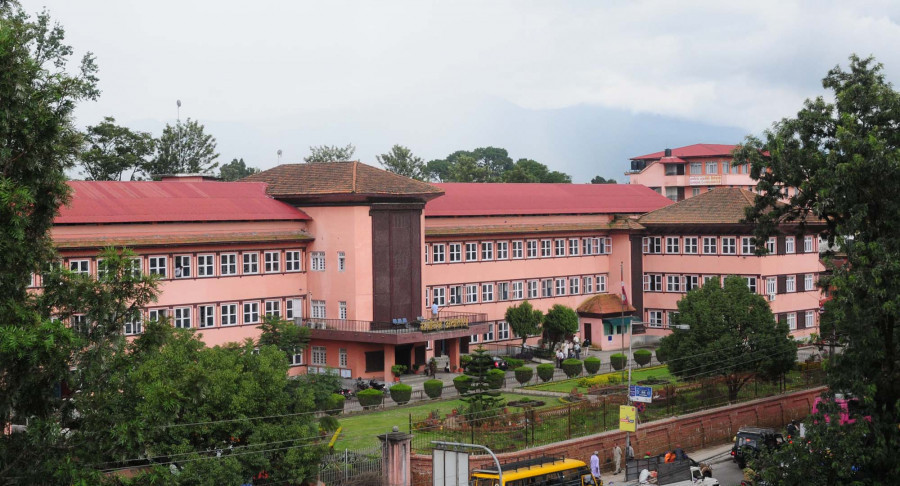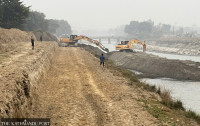National
Constitutional Bench asks for reasons for House dissolution, seeks amicus curiae
The five-member bench also asks about the time of the no-confidence motion filed against the Oli government. There are conflicting versions on when it was registered.
Binod Ghimire
Indications are that it will be a while before the Supreme Court will give a verdict on the constitutionality of the KP Sharma Oli government’s Sunday move of dissolving the House of Representatives.
A hearing on 13 writs against President Bidya Devi Bhandari’s dissolution of the House on the recommendation of the Oli Cabinet began on Friday, but the next hearing is scheduled for January 6.
The Constitutional Bench ended Friday’s hearing after listening to opening remarks of a handful of lawyers and making four significant orders. These include a show cause notice against the Office of the President and the government demanding a written justification for their move to dissolve the House.
It has sought clarification from them asking why the court should not issue an order as demanded by the petitioners who have sought revocation of the President's approval to dissolve the House based on the government’s recommendation.
“If there is any legal ground not to issue a ruling as demanded by the petitioners, submit the details by January 3 through the Office of the Attorney General,” reads the order.
The five-member Constitutional Bench led by Chief Justice Cholendra Sumsher Rana also asked the government to present the original copy of its decision regarding the House dissolution.
Another significant order is to produce before court the original copy that shows the exact time a no-confidence motion was registered against Prime Minister KP Sharma Oli in the Parliament Secretariat on Sunday, the day President Bhandari dissolved the House of Representatives.
“As one of the writs (077-wc-0037) mentions the registration of a no-confidence motion at the Parliament Secretariat, produce the original copy that shows when and at what time the application was registered,” reads the order.
The time of no-confidence motion registration is important as the Supreme Court in 1995 had ruled against then CPN-UML-led Manmohan Adhikari minority government’s dissolution of Parliament saying that the recommendation for dissolution was made after a no-confidence motion had been filed against it. The other reason that the court had given for its ruling was there was still the possibility of forming a government through a House vote.
However, there are conflicting versions on the exact time of the registration of the no-confidence motion.
Roj Nath Pandey, spokesperson for the Parliament Secretariat, issued a statement on Thursday, saying the motion was registered at 3:30pm—after the President had dissolved Parliament.
On the other hand, according to the secretariat of Speaker Agni Sapkota it was registered at 10:30am—before the dissolution.
The Constitutional Bench has also asked for the list of lower house members showing their party affiliation and the strength of different political parties in the House.
Given the gravity of the case, the Constitutional Bench also decided to form a seven-member amicus curiae comprising three advocates from Nepal Bar Association, two from the Supreme Court Bar and one each from among senior advocates and advocates.
The amicus curiae is a group of experts comprising lawyers and experts on the constitution called by the Supreme Court whenever it considers that the issue it is looking into is a serious one and the view of experts would be helpful.
The apex court in November 2017 had called an amicus curiae on the writ demanding voting rights for civil servants and security forces assigned to election duty.
Similarly, it was called in December 2016 to decide on the election modality for the local level polls.
Before the start of the hearing, Rana on Friday constituted the Constitutional Bench comprising Justices Hari Krishna Karki, Bishowambhar Prasad Shrestha, Anil Kumar Sinha and Tej Bahadur KC. The chief justice leads the five-member bench.
Article 137 of the constitution has a provision for the formation of the Constitutional Bench led by the chief justice incorporating four justices as recommended by the Judicial Council.
Although the chief justice has the authority to pick four justices from the roster prepared as per the recommendation, there is a practice to constitute a Constitutional Bench from among senior most justices.
Rana, however, did not pick Deepak Kumar Karki and Meera Khadka who are the second and third senior most justices after him.
As the preliminary hearing began on Friday, senior advocate Dinesh Tripathi, one of the writ petitioners, had raised a question over the constitution of the bench.
He had particularly asked about the presence of KC who is 11th in ranking. In response, Rana said the bench is constituted from among the senior justices and, therefore, it was unnecessary to raise questions over its composition.
Among the members of Constitutional Bench Hari Krishna Karki is a former president of Nepal Bar Association who belonged to the Progressive Lawyers’ Association which is close to the left parties, particularly the erstwhile CPN-UML. He was appointed attorney general in October 2015 after Oli became prime minister for the first time. Karki, who ranks fourth among the justices of the Supreme Court, will succeed Rana as chief justice.
Shrestha, a cadre of the Judicial Service Commission, was appointed Supreme Court justice from among chief judges of the high courts together with Karki and Sinha. He ranks fifth among the justices and would have been selected for the Constitutional Bench if the bench comprised only the senior most justices. He is also in line to be the chief justice after Rana and Hari Krishna Karki.
Sinha, another member of the bench, was appointed Supreme Court justice together with Karki and Shrestha in April 2016 from the Nepali Congress quota.
According to a senior official of the judiciary, Sinha is among the few in the apex court to maintain a high level of integrity.
Lawyers and even the officials of the court were particularly surprised to see KC on the bench.
“KC is close to Rana and that may be the reason why he may have chosen him despite being ranked 11th,” a senior court official told the Post on the condition of anonymity because he is not allowed to comment on the matter.
Although Tripathi raised the question over the formation of the bench, Tulasi Simkhada, another petitioner, doesn't see a problem with it.
“We have to believe everyone in the 14-member roster is competent to be on the bench,” he told the Post. “Friday's ruling has proved it.”
He said he expects the court will make a decision based on constitutional provisions. In his writ, Simkhada has demanded a verdict be given within 30 days, as the country cannot afford to be in limbo for a long time.
But that is unlikely as when the hearing resumes on January 6, it will already have been 17 days since the House dissolution.
Constitutional experts said it seems it will take some time for the final verdict but that shouldn’t be taken otherwise looking at the gravity of the issue.
They, however, welcomed the ruling that there can be no extension of the time given to the Office of the President and the Cabinet to furnish their explanations behind the House dissolution.
“It’s a serious constitutional issue. Therefore, it can take some time,” Balaram KC, a former justice at the Supreme Court, told the Post. “It’s fine to take time but that has to result in a mature decision.”




 9.12°C Kathmandu
9.12°C Kathmandu















